7 Useful Plantar Fasciitis Relief Methods for Burnaby, BC Residents


What Is Plantar Fasciitis?
Plantar Fasciitis is pain that’s felt in the heel and/or arch of your foot.
It can be on one foot or both, and range from being mild in nature to excruciatingly painful.
It is one of the most common reasons for patients to seek care at medical outpatient clinics when they have heel pain.
In today’s guide, specifically designed for Burnaby residents, we’ve compiled essential information on plantar fasciitis and effective exercises to relieve foot pain.
If you’re also interested in a holistic approach to pain relief, check out our insights on integrating chiropractic care with massage therapy for comprehensive treatment: 10 Benefits Of Integrating Chiropractic Treatment With Massage Therapy.
Where Is the Plantar Fascia Located In The Body?
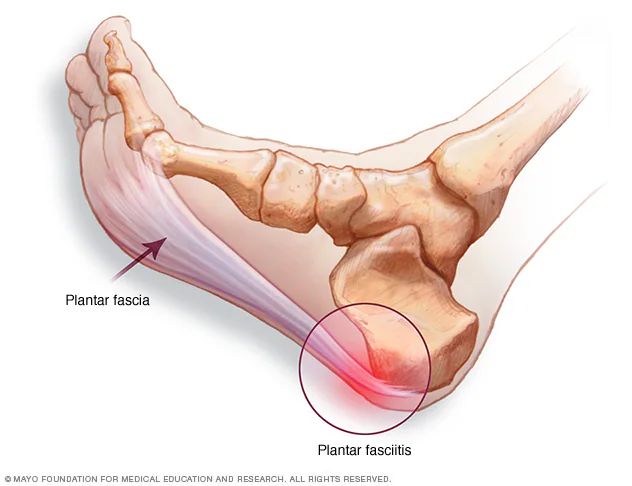
Image Source: Mayo Clinic
The plantar fascia is a structure that supports the arches of your feet, and essentially your entire body weight.
Small tears in the fascia will cause inflammation and ultimately heel pain that causes this common condition.
The picture above illustrates the location of the plantar fascia, with the areas in red highlighting areas that are typically inflamed with overuse.
What Does Plantar Fasciitis Feel Like?
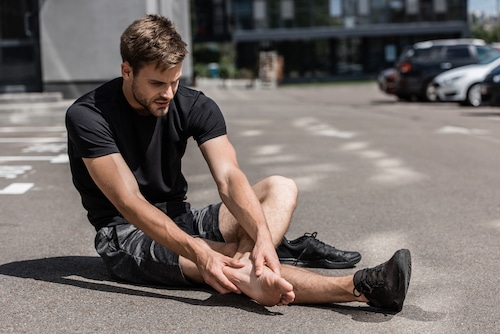

A typical presentation of plantar fasciitis would present as pain in the morning within the first few steps described as “sharp or stabbing” which may make it unbearable to walk, but decrease/subside once you start moving.
The pain may also return during the day after having stood for long periods of time or after sitting for a while, and can even be worse after exercise.
How Common Is Plantar Fasciitis and Who Gets It?


Plantar fasciitis affects a significant portion of Burnaby’s active community, with estimates suggesting around 10% of the population will experience it at some point. Whether you’re an avid runner on the scenic trails of Burnaby or someone standing for long hours due to work, you’re not alone in seeking relief.
However, even young and old athletes involved in running, ballet, soccer and tennis are susceptible to plantar fasciitis. Typically, the most common type of individual affected are those that are in the working age between 20-65 years.
Why Did I Get Plantar Fasciitis?


For many Burnaby residents, the sudden increase in activities like running, especially in our beautiful but challenging terrain, can lead to plantar fasciitis.
The condition also commonly affects individuals in professions that require standing for extended periods, a common scenario in our bustling local Burnaby economy.
That said, plantar fasciitis pain may also be felt when a patient engages in activities that are long in duration and involve running/jumping movements.
What’s The Most Common History Of A Plantar Fasciitis Patient?


In clinical practice, one of the most common patterns we see is a patient who has recently started running, but without a proper progressive running program.
As a result, musculature in his/her lower body has not had the appropriate time to adapt to the stresses that are needed to support their body.
In addition to poor running mechanics, the patient may be using old or improper footwear, avoiding a proper cool down/recovery, and not have engaged in stretching/strength training.
What Are The Risk Factors of Plantar Fasciitis On Clinical Examination?
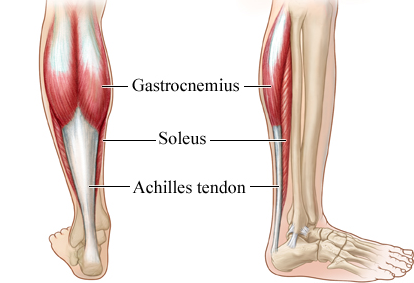

A clinical examination often reveals the following common findings:
- Foot anatomy and mechanics such as having flat feet or a high arch, and/or an abnormal walking pattern.
- Weakness in the glutes and core musculature secondary to detraining
- Obesity and/or pregnancy
- Occupation(s) common in Burnaby’s diverse economy, from healthcare to retail and construction, often require prolonged standing or walking on hard surfaces, significantly contributing to the risk of developing plantar fasciitis.
- Improper or inadequate footwear- wearing shoes with worn out soles and support or shoes with lack of support. The converse can also be true when footwear needs to be heavy to prevent injury (i.e. steel toe boots) which lead to more work being done by the plantar fascia.
When Should I Consult A Doctor About My Heel Pain?


Most people will recover from plantar fasciitis in a few months of adhering to conservative treatments such icing, stretching and resting.
However, if you are not seeing improvements in your heel pain after about 2 weeks, or there is even an increase in your pain, it would be wise to make an appointment with your doctor before it escalates to a more severe condition such as a degenerative condition at the heel.
What Happens If I Don’t Treat Plantar Fasciitis?


If left untreated, extreme cases of heel pain and plantar fasciitis can lead to degeneration at the heel where the fascia attaches to, or even be a sign of a stress fracture or a compressed nerve.
Therefore, it is important not to ignore your heel pain if it persists for more than a couple of days and seek medical advice as soon as possible from a licensed healthcare professional.
Is There Anything I Can Do At Home To Treat My Foot Pain?
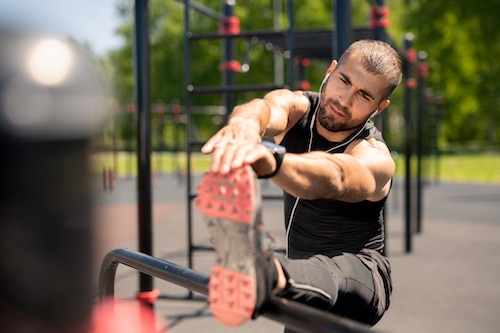

The good news is that plantar fasciitis is treatable and most people are expected to make a full recovery without any long-term damage or pain if treated early.
In fact, just resting, icing, doing plantar fascia stretches and specific exercises should be enough in relieving plantar fasciitis pain.
However, in more severe cases recruiting the aid of heel cushions, night splints, and/or orthotics may be necessary, and should be discussed with your healthcare provider(s).
Below you will find some of the best exercises to help plantar fasciitis.
Here They Are – 7 Exercises for foot pain and Stretches To Relieve Most Cases Of Plantar Fasciitis
Below is a series of exercises and plantar fasciitis stretches to help relieve your pain.
Please remember that if you experience any pain with an exercise, that you should stop immediately and seek advice from your doctor or a licensed healthcare professional.
Soleus Stretch:
Put your injured foot behind your uninjured foot with a bit of space separating the feet, and then gently bend both knees until you feel a deep stretch behind the calf muscle of the injured foot.
Hold this position for 20-30 seconds. Repeat 3 times on both sides.
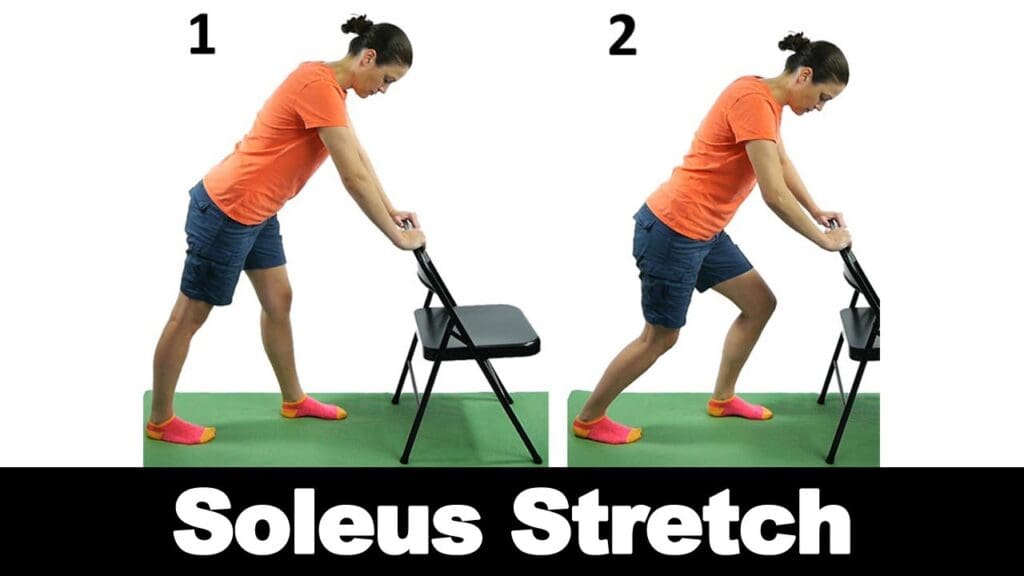

Image Source: i.timg.com
Achilles/Gastrocnemius Stretch:
Put the front of the injured foot up against the wall, while your heel rests on the floor with your knee straight.
Place your hands up against the wall for balance and then gently bring your upper body closer to the wall until you feel a stretch in the calf muscle.
This should feel like a lighter stretch than the soleus stretch, as you are stretching the more superficial lower leg muscles here.
Hold this position for 20-30 seconds. Repeat 3 times on both sides.
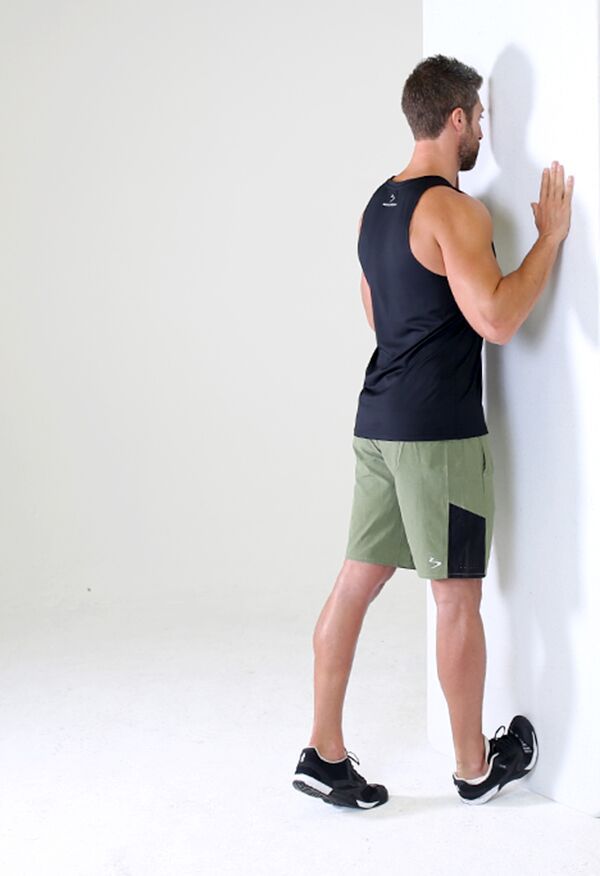

Image Source: i.pinimg.com
Plantar Fascia Stretch:
Sitting with your legs outstretched in front of you, loop a towel or band under the ball of your foot and gently pull back on your foot, as you imagine bringing the tops of your toes towards your shin.
The stretch should be felt under your foot and at the back of your heel.
Hold this position for 20-30 seconds. Repeat 3 times on both sides.


Image Source: hips.hearstapps.com
Towel Toe Curls:
Starting in a seated position with both feet flat on the floor, place a towel under your affected foot and scrunch your toes to grab the towel.
Then release the towel and relax your toes.
As you perform this exercise, try to focus on the intrinsic muscles of your arch and feet as these are the muscles that need to be strong.
Repeat this exercise 10 times for 3 sets.
Plantar Fascia Massage:
Either sitting or standing to start, place a tennis ball under your foot and roll it under your arch and heel.
You can even try this with a frozen water bottle and it will ice the injured area to provide you with further relief.
Do this exercise for 5 minutes, 3 times a day.
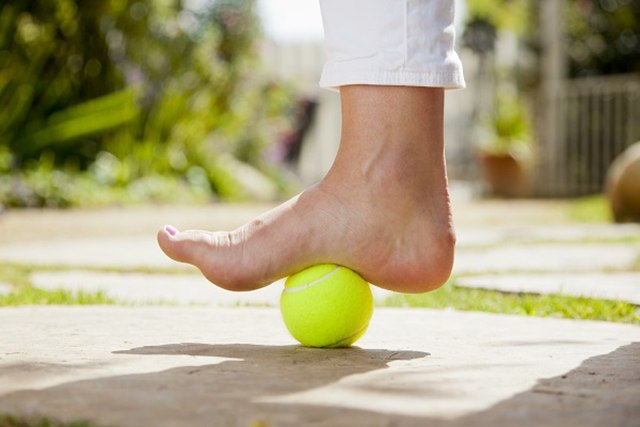

Image Source: happynetty.com
Toe Extensions:
Stand with your feet shoulder width apart, engage your core and press your heel and ball of foot into the ground and lift your toes off the floor.
Repeat this exercise 10 times for 3 sets.
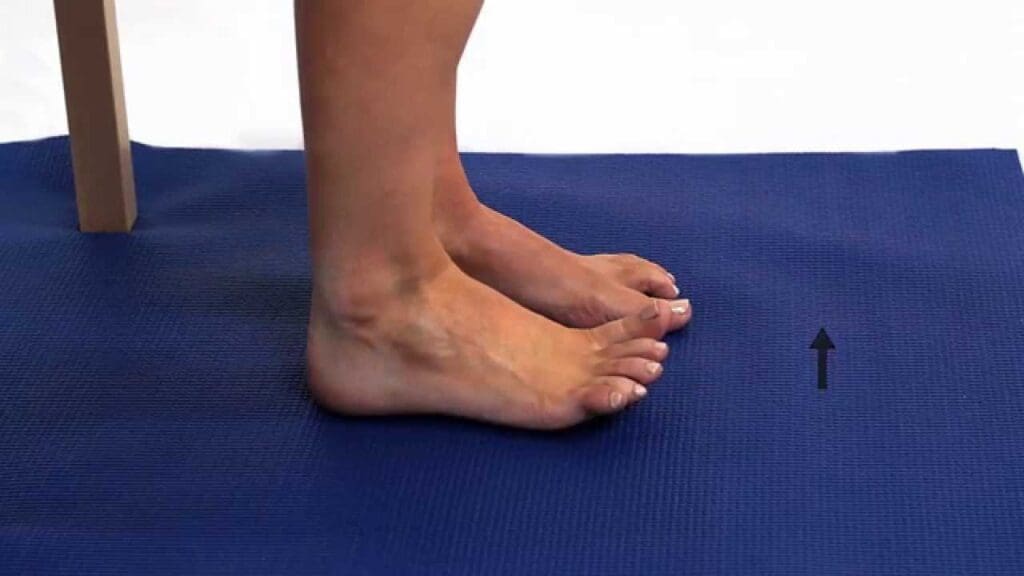

Image Source: i.timg.com
Heel raises:
This is the most complex exercise, and involves the patient standing on the edge of a step with their heels hanging off the edge of the step, while holding onto the wall or a handle for support.
Engage your abdominals and drop your heels slightly below the step and then press up through the balls of your feet to lift yourself up.
Then lower yourself back to your starting position. Make sure your movements are not rushed and you are moving up and down in the vertical direction and never simply forwards and backwards.
Perform this exercise 10 times, 3 times a day.
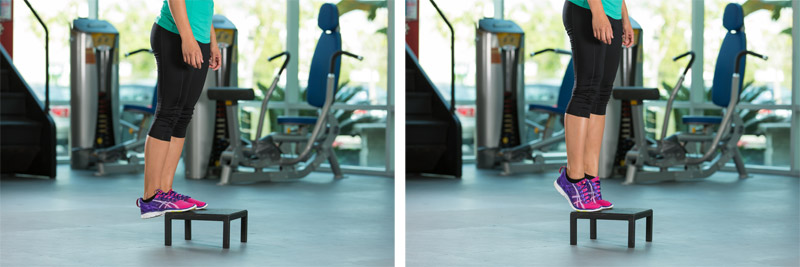

Image Source: acewebcontent.azureedge.net
Why Is It Important to Stretch and Strengthen Both Legs?


While it is important to directly address the injured foot, it is important to perform the following exercises and stretches for both feet.
Oftentimes injuries will enable you to overcompensate with the healthier side, creating additional stress and strain. As a result, you may end up with the healthier side no longer functioning optimally as well.
In fact, it is not uncommon for those suffering from plantar fasciitis to change their walking patterns that ultimately lead to more foot pain, hip, or back problems, especially without any source of personal and/or professional treatment.
However, if you are pressed for time and your plantar fasciitis affects only one of your feet choose to do these exercises and stretches for the injured foot.
Better to do something than to ignore the injury completely!
Should I Try To Strengthen My Leg Muscles As Well?


If you are making good progress in relieving your foot pain, one idea to help prevent plantar fasciitis from coming back is to engage in lower limb strengthening in a careful and controlled manner. You might also want to explore exercises for relieving back spasms. Check out our article on How To Treat Back Spasms: 5 Ways To Relieve Back Spasms for valuable tips.
This may include doing squats, lunges, and single leg stance activities that strengthen lower limb musculature and the intrinsic muscles of your feet. It is important to consider that when doing all of the above strengthening, that you try to put the arch of your foot in a “short foot” position.
This will reduce the likelihood of re-aggravating your plantar fascia and stabilizing your feet.
There is a picture of this exercise below, however since it is nuanced, feel free to ask your medical practitioner for guidance on how to execute it.
Alternatively, if you are trying to do the exercise and feel an increase in foot or arch pain, please contact your medical practitioner.
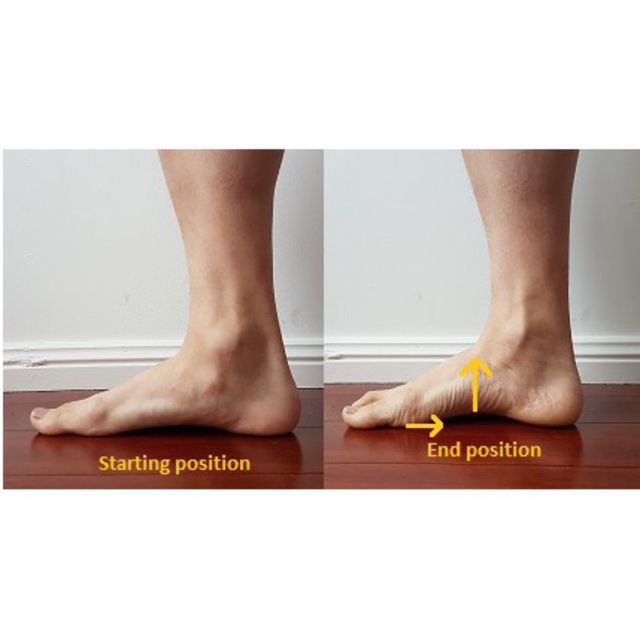

Image Source: prod.skimable
What Can I Do If My Stretches/Strengthening Fails To Relieve My Foot Pain?
As mentioned earlier, there are many medical devices that can help alleviate plantar fasciitis symptoms.


Image Source: orthomed.ca
One is called an air brace, and its primary purpose is to relieve tension in the foot and plantar fascia area.
Another alternative is a night splint, whose goal is to apply a gentle stretch to lengthen the plantar fascia that would otherwise be inflamed and fibrotic from overuse.
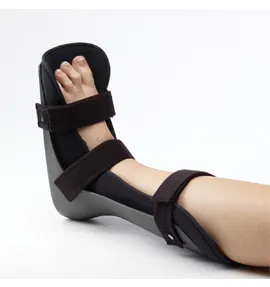

Image Source: orthomed.ca
Can Custom Orthotics Help Treat Plantar Fasciitis?
Custom orthotics are often prescribed to help treat plantar fasciitis symptoms and can be very effective at treating this common malady. If you’re curious about the cost and who might benefit from custom orthotics, read our article on How Much Are Custom Orthotics And Who Needs Them? for more information.
The reason behind their effectiveness is they can be worn in most shoes, and help to restore a normal arch in a patient’s foot.
This effectively shortens the length of the plantar fascia, lessening inflammation, pain, and soreness.
At Metrotown Family Chiropractic in Burnaby, we specialize in prescribing and dispensing custom orthotics tailored to your needs. These are effective in treating plantar fasciitis and are covered by most local insurance plans. Click here to learn more about them.
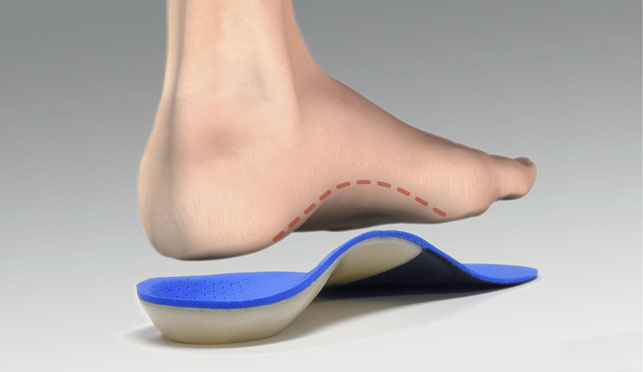

Image Source: canadianfootclinic.com
Stretches And Exercises Have Not Helped – Is There Anything Else I Can Do Try To Fix My Plantar Fasciitis?
In the most severe cases, plantar fasciitis exercises may not work for you, and in this situation your physician might refer you to a foot surgeon.
Most studies estimate only 5% of plantar fasciitis patients require this, and they often recommend waiting at least 6 months before considering surgical intervention.
The surgery is performed by cutting and releasing part of the plantar fascia ligament to decrease tension, swelling, and consequently pain.
Depending on your surgeon, it may be performed either as an open surgery or endoscopically.
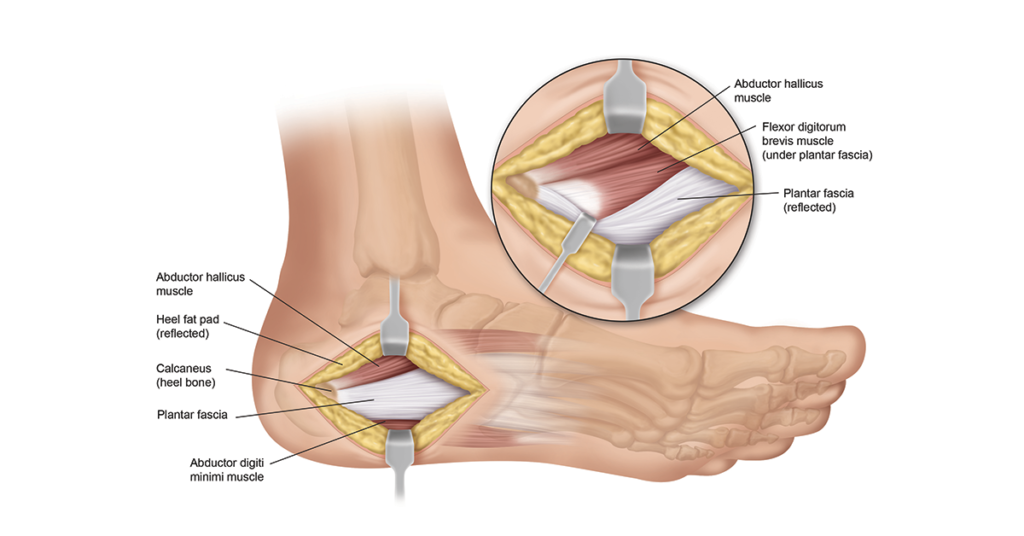

Image Source: heelthatpain.com
We Wish You Good Luck!
On behalf of the practitioners and staff at Metrotown Family Chiropractic and custom orthotics clinic in Burnaby, we wish you the best of luck in recovering from your arch pain. If you’re interested in relieving low back pain as well, check out our guide on 10 Stretches To Alleviate Your Low Back Pain.
We hope you’ve found the above guide helpful and informative to help ease your pain.
Once again, if you have any specific questions, we strongly encourage you to contact your medical practitioner.
Ready to Seek Professional Help for Your Plantar Fasciitis?
If you’re in the Burnaby area and struggling with the pain of plantar fasciitis, don’t hesitate to reach out for expert care. At Metrotown Family Chiropractic and Custom Orthotics Clinic, our experienced team of professionals is here to help you find relief and get back on your feet.
We specialize in treating various musculoskeletal issues, including plantar fasciitis, and offer tailored solutions to suit your needs. Take the first step towards a pain-free life by scheduling a consultation with our Burnaby chiropractor today. Your journey to wellness begins here.


